|
This topic includes:
Overview
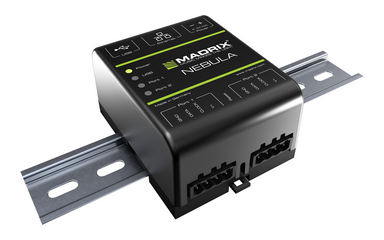
MADRIX NEBULA is a flexible interface to directly control a wide range of digital LEDs.
The MADRIX NEBULA directly connects to your LED pixels. This advanced SPI decoder receives control data over USB or Art-Net over Ethernet network and is built to provide excellent image quality.
An additional MADRIX KEY [i.e., a software license] is required for usage with MADRIX.
3rd-Party Controllers
MADRIX NEBULA is a standard Art-Net node. Because of this, you can use the device with applications, consoles, desks, or controllers that are compatible with Art-Net to distribute Art-Net data via Ethernet network.
Supported LEDs
MADRIX NEBULA supports the following LEDs [as of February 2018 with firmware version 1.4.7082]:
The protocols above currently have the following frequencies implemented and available:
Protocol
|
Frequency
|
Special Remarks
|
|
|
|
|
|
|
|
|
|
|
|
|
|
|
|
|
|
|
|
|
|
|
|
|
|
|
|
|
|
|
|
|
|
|
|
|
|
|
|
|
|
|
|
|
|
|
|
|
|
|
|
|
|
|
|
|
|
|
|
|
|
|
|
|
|
|
|
|
|
|
|
|
|
|
|
|
|
|
|
|
|
|
|
|
|
|
|
|
|
|
|
|
|
|
|
|
|
|
|
|
|
|
|
|
|
|
|
|
Putting The Device Into Operation
1] Connecting Your LEDs
Please see the MADRIX NEBULA Quick Start Guide & Technical Manual on how to connect your LEDs to MADRIX NEBULA.
»help.madrix.com
2] Connecting To Power And Data
Please see the MADRIX NEBULA Quick Start Guide & Technical Manual on how to connect to power and data.
»help.madrix.com
3] Setting The Output Protocol
In order to put MADRIX NEBULA fully into operation, it is necessary to set the correct output protocol according to the LEDs you have connected.
You can set the output protocol in different ways:
Web Configuration
When connected to Ethernet computer network, you can easily configure MADRIX NEBULA using a web configuration interface.
You have 2 options to access the web interface:
A] Open your web browser and enter the IP address of MADRIX NEBULA.
[Both, NEBULA and your computer, need to be in the same network.]
B] Use MADRIX.
| ▪ | Go to Preferences > Device Manager... > Art-Net
[Keyboard shortcut: F4 > Art-Net] |
| ▪ | Select your MADRIX NEBULA device in the list. |
| ▪ | Click  |
| ▪ | Your default web browser will open. |
| ▪ | Now, you have access to various information and settings. |

Device Name
|
You can change the description of the device. Enter a name and confirm your input with Set. This label is only shown in this web interface.
|
Device Settings
|
You can change the IP address and Subnet Mask. Enter the specific addresses and confirm with Set.
|
Output Settings
|
This section shows specific settings for the output ports [Port 1 and Port 2].
Art-Net Universe - By default, Art-Net universes 1 - 4 are assigned to Port 1 and Art-Net universes 4 - 8 are assigned to Port 2.
- If you are broadcasting data for a large number of Universes [using Broadcast Mode instead of using Direct IP Mode] with MADRIX or a 3rd-party controller for example, you can assign different DMX universes to each device with these settings. Each MADRIX NEBULA will then only receive data from the specific Art-Net universe and send it to its specified output port.
- Example: You can set up that NEBULA #1 only listens to Art-Net universe 1 - 8, while NEBULA #2 listens to Art-Net universe 9 - 16, and NEBULA #3 listens to Art-Net universe 17 - 24, and so on.
Output Protocol - In order to put MADRIX NEBULA fully into operation, it is necessary to set the correct output protocol according to the LEDs you have connected. You can set it up here.
- Choose a signal frequency according to the specifications of your LEDs.
- If you do not have this information, choose a signal frequency that works for your LEDs. If the refresh rate is set too high, you will usually notice that your LEDs flicker uncontrollably. If that is the case, choose a lower frequency.
- Certain LEDs need to be addressed first. If your LEDs need to be addressed and have not been addressed yet, please address them first. Learn More
Channels Per Universe - Allows you to define how many DMX channels are sent per DMX universe for each port. This option enables you to adjust the device settings to the controller and LEDs you are using.
- Automatic: The number of channels that is received is also sent out. This is the default value. This is also the recommended setting when using NEBULA in combination with the MADRIX software.
- 1 - 512: Limits the number of output channels to this value. If your controller sends more channels than set up here, any channels that are higher than this value will be discarded. If your controller sends fewer channels, NEBULA will fill up the rest of the channels with values of 0 [Black].
- Using RGB LEDs: 170 RGB LEDs can be controlled with one single DMX universe. That means a maximum of 510 DMX channels is used. Depending on your controller [please see below], the recommended setting is Automatic or 510.
- Using RGBW LEDs: 128 RGBW LEDs can be controlled with one single DMX universe. That means a maximum of 512 DMX channels is used. Depending on your controller [please see below], the recommended setting is Automatic or 512.
- Using 1-channel LEDs: 512 single color LEDs can be controlled with one single DMX universe. That means a maximum of 512 DMX channels is used. Depending on your controller [please see below], the recommended setting is Automatic or the number of LEDs used.
- Using MADRIX: By default, MADRIX sends optimized frames as set up in the Device Manager. That means according to the number of channels used by the fixtures and Patch, MADRIX and then NEBULA will send out the correct number of channels to the LEDs.
- Using a 3rd-party controller: When your controller is only able to send full frames [which means that it always sends 512 DMX channels per single frame], it is recommended to set up a specific value here as described above in order to correctly work with MADRIX NEBULA and your LEDs. Recommendation: If using RGB LEDs, set up 510 channels per universe.
|
Device Information
|
This section displays various details about the device, including:
| ▪ | IP Address [Current IP address] |
| ▪ | MAC Address [A permanent, unique address] |
| ▪ | Firmware [Current firmware version] |
| ▪ | Bootloader [Current bootloader version] |
| ▪ | Hardware [Hardware model] |
| ▪ | Voltage [The current voltages for Input, Port 1, and Port 2.] |
| ▪ | Temperature [The current ambient temperature.] |
|
Please Note Regarding LEDs That Need Be Addressed First
Certain LEDs need to addressed first. Please check the below table to see if your LEDs might need to be addressed.
| ▪ | If they are already addressed with another tool, you do not need to address them again. |
| ▪ | If your LEDs are not yet addressed, please address them:
1. Connect your LEDs as described above.
2. Connect to power and data as described above.
3. Choose the corresponding Addressing Protocol as Output Protocol of the MADRIX NEBULA. Confirm with 'Set'. You only have to do this once for your each LED tape.
4. Once your LEDs are addressed, continue by selecting the correct Output Protocol according to your LEDs. |
LED
|
Addressing Protocol
|
|
| ▪ | Choose the Addressing Protocol 'WS2822S Addressing' in order to address your LEDs. |
|
MADRIX Device Configuration
You can access all information and settings of the web configuration in MADRIX using the MADRIX Device Configuration window.
| ▪ | In MADRIX, go to Tools > MADRIX Device Configuration...
[Keyboard shortcut: Ctrl+Alt+L] |
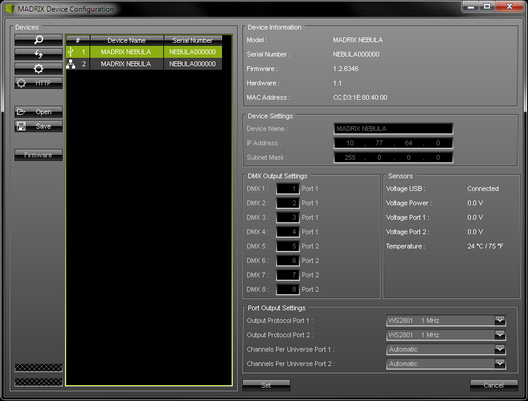

|
| ▪ | Scans the USB ports of your computer and the network for connected MADRIX NEBULA devices. If devices are found, they will be shown in the list.
- To see USB devices, you need to enable NEBULA USB drivers first [they are activated by default]. Learn more »Devices USB
- To see network devices, you need to enable NEBULA networking drivers [they are activated by default] as well as connect MADRIX NEBULA and your computer to the same network first. Learn more »Devices Network |
|

|
| ▪ | Refreshes already connected devices and brings the information in the list up to date. |
|

|
| ▪ | Allows you to change the settings of your device. Apply your changes by confirming with Set |
|

|
| ▪ | Enables remote access to the web configuration as explained above. MADRIX NEBULA needs to be connected via Ethernet [network connection required]. First, connect your computer and the MADRIX NEBULA to one and the same network. Second, select your MADRIX NEBULA in the list. Third, click this button. A web browser opens automatically. |
|

|
| ▪ | Imports the MADRIX NEBULA Device Settings from an external file [of the file type *.mndx]. Use this option to easily restore all device settings from a file [as described below]. |
|

|
| ▪ | Exports the MADRIX NEBULA Device Settings to an external file [of the file type *.mndx]. Use this option to easily store all device settings in a file. Simply enter a name in the window that opens and click 'Save'. |
|

|
| ▪ | Updates the firmware of your MADRIX NEBULA if a newer firmware is available [USB connection required]. |
|
Learn more Web Configuration
Operating Modes
You can use 2 operating modes together with MADRIX:
Data Output Over Ethernet Network [Art-Net]
Overview
You can connect the NEBULA over Ethernet network to the network card of your computer that runs the MADRIX software. Data is distributed to the device over network cabling [Ethernet] and sent to the output ports [Port 1 and Port 2].
1] Initial Configuration
| ▪ | Put MADRIX NEBULA into operation by connecting the LEDs, supplying power, and setting the output protocol as described above. Learn more Putting The Device Into Operation |
| ▪ | Connect MADRIX NEBULA to your computer using Ethernet network cabling. |
| ▪ | It is highly recommended to use Gigabit Ethernet network components [network card, switches, etc.]. |
2] Windows Network Settings
Art-Net is a network-based protocol. MADRIX will use the network card of your computer to send data.
| ▪ | It is required to set up the correct network settings in Windows, first. |
| ▪ | You must use these IP address and Subnet mask settings. Otherwise, Art-Net might not work! |
| ▪ | The IP addresses of your computer and your MADRIX NEBULA devices need to be different.
|
| ▪ | Set up an individual IP address in the following IP address range:
- 2.0.0.1 ... 2.255.255.254 or
- 10.0.0.1 ... 10.255.255.254 |
| ▪ | Set up the corresponding Subnet mask
- 255.0.0.0
[Via factory default settings, MADRIX NEBULA devices will have an IP address in the 10.x.x.x network range, such as 10.77.64.86, for example].
|
| ▪ | Restart MADRIX, if you have changed the network settings in Windows while MADRIX was running. |
| ▪ | Example for PCs that are running MADRIX: |

3] Fixture Configuration In MADRIX
4] Activating Art-Net
| ▪ | Go to Preferences > Device Manager... > Art-Net
[Keyboard shortcut: F4 > Art-Net]
|
| ▪ | Activate the checkbox Enable [in the upper, right corner].
|
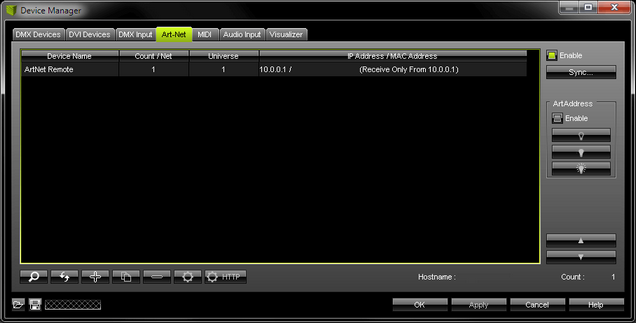
5] Adding Devices Automatically
MADRIX can automatically add your MADRIX NEBULA devices.
| ▪ | Click 
[MADRIX will automatically search the network for connected devices. Devices that are found will appear in the list. Two entries will be created in the list for each NEBULA device.]
[The Art-Net standards only supports a maximum of 4 output ports per device. Since NEBULA features 2 ports, 2 list items are created in MADRIX.]
|

6] Activating Devices
Each of your MADRIX NEBULA devices and its ports need to be activated. By default, they are still deactivated.
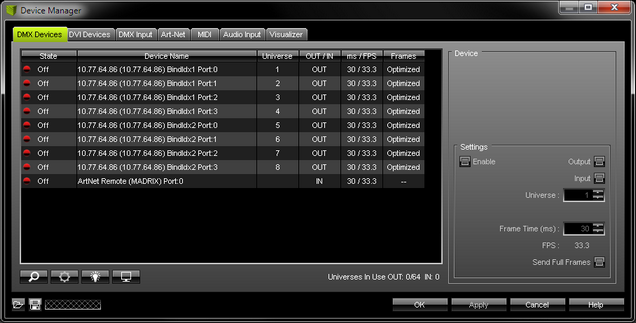
| ▪ | Go to Preferences > Device Manager... > DMX Devices
[Keyboard shortcut: F4] |
| ▪ | Select your devices and their ports in the list. 8 output universes will be shown. |
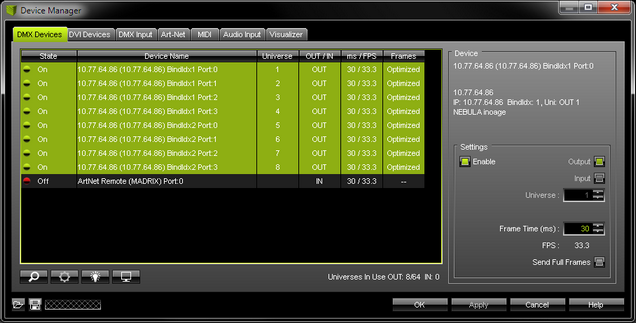
| ▪ | [In the screenshot above, one NEBULA is connected. If more devices are connected, please use the different IP addresses of different devices to identify them in the Device Manager. You can also click on Device Name as well as Universe or other columns to sort the list accordingly.] |
7] Configuration Of DMX Output
| ▪ | Make sure that your output port is still selected under Preferences > Device Manager... > DMX Devices |
| ▪ | Set up Universe
- Enter the specific DMX universe number. |
| ▪ | This setting assigns a specific DMX universe [of the Patch] to the device or the port of the device. |
| ▪ | Make sure the correct universe is assigned according to your requirements.
Learn more »Glossary |
| ▪ | By default, DMX universe 1 - 8 are assigned when using one MADRIX NEBULA.
|
NEBULA Output Universe
|
Device Manager... > DMX Devices > Device Name
|
DMX 1
|
BindIdx1 Port:0
|
DMX 2
|
BindIdx1 Port:1
|
DMX 3
|
BindIdx1 Port:2
|
DMX 4
|
BindIdx1 Port:3
|
DMX 5
|
BindIdx2 Port:0
|
DMX 6
|
BindIdx2 Port:1
|
DMX 7
|
BindIdx2 Port:2
|
DMX 8
|
BindIdx2 Port:3
|
8] Frame Time
| ▪ | Make sure that your device is still selected under Preferences > Device Manager... > DMX Devices |
| ▪ | Set up Frame Time (ms)
- The Frame Time affects the Frame Rate. The Frame Rate specifies how fast data is sent to the device or received from it [Frames Per Second; FPS].
- Increase the Frame Time in order to decrease the Frame Rate [e.g., 40ms = 25 FPS].
- Decrease the Frame Time in order to increase the Frame Rate [e.g., 20ms = 50 FPS].
- The default value is 30 ms / 33.3 FPS.
- Some LED fixtures might have problems with a high Frame Rate. Then, it is recommended to increase the Frame Time / to decrease the Frame Rate. |
| ▪ | [When using Art-Net, the Frame Time [ms] can be individually set for each port. But it cannot be set individually for each port, when Sync Mode is activated. Learn more below.] |
9] Optimized Frames Or Full Frames
| ▪ | Make sure that your device is still selected under Preferences > Device Manager... > DMX Devices |
| ▪ | Activate or deactivate Send Full Frames
- Per DMX512 standard, MADRIX only sends the number of DMX channels that is configured. For example, if you are using 312 DMX channels on a DMX universe, only 312 DMX channels will be sent with every single frame on this universe [Optimized Frames].
- Activate Send Full Frames if devices should always send full frames on a particular universe, instead of optimized frames. Sending full frames means that always the full 512 DMX channels of a DMX universe will be sent with every frame [even when you are using less than 512 channels].
- When using only single-color or RGBW fixtures in the Patch, activating Send Full Frames is recommended if problems with the data output on your LEDs occur. |
| ▪ | In addition, you can activate Full Frames for the device and each MADRIX NEBULA output universe separately. |
Sync Mode
MADRIX NEBULA can use the special sync mode of MADRIX.
| ▪ | Large LED projects require dependable data distribution. The MADRIX software and NEBULA hardware allow you to synchronize data output for all ports and even across multiple devices to get an optimal image on the LEDs. |
| ▪ | When MADRIX Sync mode is activated, MADRIX and MADRIX NEBULA will automatically handle the synchronization of data. |
MADRIX Sync Mode is highly recommended for MADRIX NEBULA!

|
Sync Mode - Allows you to activate or deactivate the usage of sync packages for Art-Net.
|
| ▪ | Before activating sync, make sure that all activated Art-Net devices are available in your network! Else, the frame rate of Art-Net might drop. If you are not sure, do not enable any sync mode. |
| ▪ | Go to Preferences > Device Manager... > Art-Net
[Keyboard shortcut: F4 > Art-Net] |
| ▪ | Select the network for which you want to activate Sync Mode. |
| ▪ | Click Enable to activate the Sync Mode for the selected network. |
| ▪ | A] Choose Pre-Sync to send sync packages before Art-Net data. |
| ▪ | B] Choose Post-Sync to send sync packages after Art-Net data. |
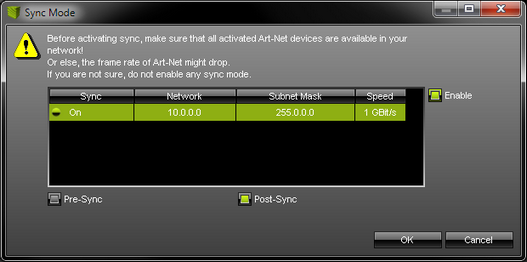
| ▪ | To disable sync mode, click Sync... again, select the correct network, and deactivate Enable. Confirm with OK |
Additional Art-Net Device Settings
It is very important to set up the correct settings for your devices!
Broadcast Mode Or Direct IP Mode
MADRIX can send Art-Net data in 2 ways to your Art-Net devices:
| ▪ | Broadcast Mode - Means that every packet sent from a single transmitter will be received by all recipients in the network. MADRIX will send data to all devices in the network.
- Advantage: The same data [e.g., DMX universe 1 and 2] can be made available for different points of your setup.
- Disadvantage: A potentially huge number of data packages will be sent over the network. This can reduce the overall network performance and cause data issues or instability. |
| ▪ | Direct IP Mode - Means that the specific data will only be sent to the specified recipient.
- Advantage: Data traffic is reduced immensely, which means that a larger number of Art-Net devices can be used in one network. Reduced network traffic increases the performance and stability.
- Disadvantage: The network settings of all devices need to be 100% correct. |
Direct IP Mode is recommended in general.
| ▪ | Go to Preferences > Device Manager... > Art-Net
[Keyboard shortcut: F4 > Art-Net] |
| ▪ | Select your device in the list. |
| ▪ | Click  |
| ▪ | A] Choose Direct IP Mode to activate Direct IP mode:
- Make sure to enter the correct IP Address of your device that should receive the Art-Net data. When MADRIX NEBULA has been automatically found by MADRIX, the IP address will be pre-configured for you.
- MADRIX will send the corresponding data only to this device. |
| ▪ | B] Choose Broadcast Mode to activate Broadcast Mode:
- Make sure to select the correct Network card of your computer that should send the Art-Net data. When MADRIX NEBULA has been automatically found by MADRIX, the correct network will be pre-configured for you.
- MADRIX will send data to the whole Art-Net network. |
More Information About Art-Net
Learn more »Art-Net [DMX Over Ethernet]
Status Indicators [ArtAddress]
In order to use these features, please Enable ArtAddress first.
[Please make sure that your nodes fully support this Art-Net feature, such as MADRIX LUNA, MADRIX NEBULA, MADRIX PLEXUS, MADRIX STELLA. You will also get notified by a message box. Confirm the message with OK or abort via Cancel.]

|
Mute Status Indicators - Switches off and disables all built-in status indicators of a device over Art-Net [ArtAddress > AcLedMute].
|

|
Operate Status LEDs Normally - Allows the built-in status indicators of a device to operate normally again, after having them switched off [ArtAddress > AcLedNormal].
|

|
Highlight Device - Activates the highlight mode [ArtAddress > AcLedLocate]. Select one or more interfaces and click the button. The corresponding status indicators of the selected interfaces will flash for a better identification or tests. This makes it easier to see them on site/stage. It considerably speeds up the procedure of programming or testing the selected interfaces.
|
DMX Watcher

|
DMX Watcher - Opens the DMX Watcher to monitor your data output under Preferences > Device Manager... > DMX Devices
Learn more »Tools
|
Automatic HTP Merging
Overview
| ▪ | MADRIX NEBULA features automatic HTP merging from 2 Art-Net sources. |
[Usually, the first source will be MADRIX. The second source could be a console, for example.]
| ▪ | Data from both source will be merged together and sent out as 1 signal. This happens across all output ports and by using the HTP principle. |
| ▪ | HTP - Is the acronym for Highest Takes Precedence. Data from both sources will be compared for each individual channel. The higher value wins per channel.
|
| ▪ | Example: We are using an LED fixture with a total of 5 control channels [3 color channels and 2 movement channels]. MADRIX should provide the color data for channels 1 to 3 and the console should provide the movement data for channels 4 and 5. Using the MADRIX Fixture Editor, we could create a corresponding fixture where channel 4 and 5 are set up as Fixed channel using always a value of 0. On the other hand, the console will always send a value of 0 for the first 3 channels of each fixture. This will ensure that the data from the console will always provide the higher value on channels 4 and 5, while MADRIX provides the color data. Due to the automatic HTP merging of the device, the LED fixture will receive correct data from both sources as desired. |
Configuration And Recommendations
1] Correctly set up and enable Art-Net for each source.
2] Make sure to activate Sync Mode for Art-Net in MADRIX. Learn more »Sync Mode
3] Make sure that MADRIX has a lower IP address compared to the second source.
[E.g., 2.0.0.1 compared to 2.0.0.20]
4] Always use Direct IP Mode to directly send data to the correct IP addresses of your MADRIX NEBULA devices.
[It is not recommend to have any of the two sources or any other source in the network to send data via Broadcast Mode.]
Data Output Over USB
Overview
You can connect the NEBULA directly via USB to the computer that runs the MADRIX software. Data is distributed to the MADRIX NEBULA over USB and sent to the two output ports [Port 1 and Port 2].
1] Initial Configuration
| ▪ | Put MADRIX NEBULA into operation by connecting the LEDs, supplying power, and setting the output protocol as described above. Learn more Putting The Device Into Operation |
| ▪ | Connect MADRIX NEBULA to your computer via USB.
[Use the provided USB cable.] |
2] Fixture Configuration In MADRIX
3] Enabling Drivers In MADRIX
| ▪ | Go to Preferences > Options... > Devices USB
[Keyboard shortcut: Ctrl+Alt+O > Devices USB] |
| ▪ | Close the window with OK |
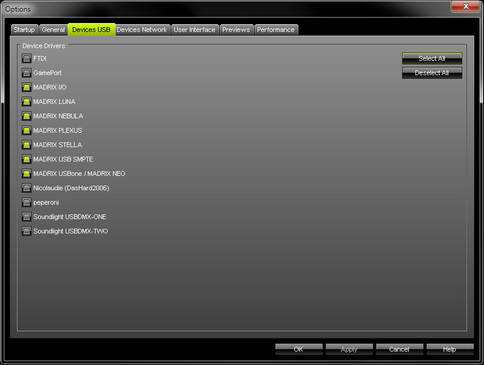
4] Activating Devices
| ▪ | Go to Preferences > Device Manager... > DMX Devices
[Keyboard shortcut: F4] |
| ▪ | Your NEBULA devices and all of their output universes will appear in the list. |
| ▪ | If your devices are not in the list, click 
[In the screenshot below, one NEBULA is connected.] |
| ▪ | By default, all output ports are activated [State On]. |

| ▪ | If your device and ports are not activated, do the following: |
| ▪ | Select the device/port in the list. |
5] Configuration Of DMX Output
| ▪ | Make sure that your output port is still selected under Preferences > Device Manager... > DMX Devices |
| ▪ | Set up Universe
- Enter the specific DMX universe number. |
| ▪ | This setting assigns a specific DMX universe [of the Patch] to the device or the port of the device. |
| ▪ | By default, DMX universe 1 - 8 are assigned when using one MADRIX NEBULA. |
| ▪ | Make sure the correct universe is assigned according to your requirements.
Learn more »Glossary |
6] Frame Time
| ▪ | Make sure that your output port is still selected under Preferences > Device Manager... > DMX Devices |
| ▪ | Set up Frame Time (ms)
- The Frame Time affects the Frame Rate. The Frame Rate specifies how fast data is sent to the device or received from it [Frames Per Second; FPS].
- Increase the Frame Time in order to decrease the Frame Rate [e.g., 40ms = 25 FPS].
- Decrease the Frame Time in order to increase the Frame Rate [e.g., 20ms = 50 FPS].
- The default value is 30 ms / 33.3 FPS.
- Some LED fixtures might have problems with a high Frame Rate. Then, it is recommended to increase the Frame Time / to decrease the Frame Rate. |
| ▪ | [When using USB, the Frame Time (ms) will be automatically set to the same value for all output ports.] |
7] Optimized Frames Or Full Frames
| ▪ | Make sure that your device is still selected under Preferences > Device Manager... > DMX Devices |
| ▪ | Activate or deactivate Send Full Frames
- Per DMX512 standard, MADRIX only sends the number of DMX channels that is configured. For example, if you are using 312 DMX channels on a DMX universe, only 312 DMX channels will be sent with every single frame on this universe [Optimized Frames].
- Activate Send Full Frames if devices should always send full frames on a particular universe, instead of optimized frames. Sending full frames means that always the full 512 DMX channels of a DMX universe will be sent with every frame [even when you are using less than 512 channels].
- When only using single-color or RGBW fixtures in the Patch, activating Send Full Frames is recommended if problems with the data output on your LEDs occur. |
| ▪ | In addition, you can activate Full Frames for the device and each MADRIX NEBULA output universe separately. |
LED Status Codes
The following tables describe the LED status codes of the device.
STATUS
|
POWER
|
Powered off
|
Power not connected. ’ The device has no power.
|
Permanently green
|
Connected to power. ’ The power is on.
|
Blinking green
|
Bootloader activated. ’ Reset the device to factory default settings.
|
STATUS
|
USB
|
Powered off
|
USB not connected.
|
Red +
blinking green
|
Communicating over USB.
’ Sending or receiving data over USB. The USB port works.
|
Fading between
red +green
|
Connected to USB; Drivers installed correctly.
’ No data is sent over USB.
|
Orange
|
Connected to USB; No drivers installed.
’ Reinstall software and drivers or try a different USB port.
|
STATUS
|
Port 1
|
Port 2
|
Powered off
|
No data is sent.
|
No data is sent.
|
Blinking green
|
Sending data to Port 1.
’ The output port works.
|
Sending data to Port 2.
’ The output port works.
|
STATUS
|
ETHERNET
|
Green off
|
10 MBit/s connected.
|
Green on
|
100 MBit/s connected.
|
Orange on
|
Network connected.
|
Orange blinking
|
Sending or receiving data. ’ The Ethernet port works.
|
Reset To Factory Default Settings
In rare cases you might need to do a reset to factory default settings, for example to reset to the device to its default IP address as shown on the side of the device:
Reset Via Reset Button
1] Disconnect all connections from the device [power, data, LEDs].
2] Use a suitable tool to press the reset button [between Port 1 and Port 2].
3] Continue to press the reset button and supply power again over 'Power' or USB.
4] Continue to press the reset button and wait until all status LEDs of the device flash repeatedly or wait 10 seconds.
[Simply repeat these steps should the process fail.]
Firmware Updates
It is highly recommended to update the firmware of the device should a new firmware version become available. You can do so in different ways.
Update Via USB
1] Connect MADRIX NEBULA to your computer over USB.
[Use the provided USB cable.]
2] Start the MADRIX software.
3] Open the MADRIX Device Configuration window. Go to Tools > MADRIX Device Configuration...
4] Click  to search for connected devices and your device will appear in the list. to search for connected devices and your device will appear in the list.
5] Select your device in the list and click Firmware
6] Wait for the process to end [usually it takes only seconds].
7] Disconnect MADRIX NEBULA from USB and power. Afterwards, connect it again.
Update Via Ethernet
| ▪ | Connect MADRIX NEBULA to power. |
| ▪ | Connect MADRIX NEBULA to your computer over Ethernet network. |
| ▪ | In MADRIX, go to Preferences > Device Manager... > Art-Net |
| ▪ | Select the device in the list. Click  . A new window opens. . A new window opens. |
| ▪ | Click Firmware
The update process will start. |
| ▪ | Wait for the process to end [usually it takes only seconds]. |
Available Firmware Updates
NEBULA Firmware
|
MADRIX Version
|
Release Date
|
Highlights
|
1.0.6127
|
MADRIX 3.6 RC
|
May 2016
|
|
1.1.6147
|
MADRIX 3.6
|
May 2016
|
| ▪ | Added new supported LEDs: P9883. |
| ▪ | Added new supported LEDs: SK6812. |
| ▪ | Added new supported LEDs: SK6822. |
|
1.1.6168
|
MADRIX 3.6a
|
July 2016
|
| ▪ | Web configuration tool: Added Voltage to the Device Information section. |
| ▪ | Web configuration tool: Added the Refresh button to always show the latest information that was last saved on the device in the web browser [instead of using a browser refresh which may change settings again]. |
| ▪ | Web configuration tool: Streamlined spelling of output protocols. |
|
1.2.6346
|
MADRIX 3.6d
|
December 2016
|
| ▪ | Added new supported LEDs: GW6201. |
| ▪ | Added new supported LEDs: TM1814. |
| ▪ | Added new supported LEDs: WS2813. |
| ▪ | Added new supported LEDs: WS2818. |
| ▪ | Changed name of supported LEDs: From TLS3001 To TLS3001 Linear. |
| ▪ | Added supported LEDs: TLS3001 Quadratic [For 12-bit LEDs]. |
| ▪ | Output settings: Added the option to define the number of channels sent per universe for each port [Channels Per Universe]. |
| ▪ | Sensor data: Devices can now report back if voltage is connected/disconnected over USB [Voltage USB]. |
| ▪ | Sensor data: Devices can now report back which voltage is used for Power, Port 1, and Port 2 [Voltage Power, Voltage Port 1, Voltage Port 2]. |
| ▪ | Sensor data: For NEBULA models V1.1 and higher, devices can now report back the ambient temperature [Temperature]. |
| ▪ | Fixed an issue that could make the device become unresponsive under certain circumstances when connecting, disconnecting, and calling up the website several times in a row. |
| ▪ | Fixed an issue that could produce display issues with the built-in web configuration tool when confirming changes via 'Set'. |
|
1.2.7014
|
MADRIX 3.6e
|
February 2017
|
| ▪ | Added new supported LEDs: MBI6120. |
| ▪ | Added new supported LEDs: WS2822S. |
| ▪ | Added new supported LEDs: WS2822S Addressing [To linearly address LEDs that haven't been initialized yet]. |
| ▪ | Added new supported LEDs: UCS512B3. |
|
1.2.7035
|
MADRIX 3.6f
|
May 2017
|
| ▪ | Added new supported LEDs: WS2811S. |
| ▪ | Added supported LEDs: MBI6120, Limit 33 % [To limit the output to 33 % of the possible maximum]. |
| ▪ | Added supported LEDs: MBI6120, Limit 66 %. [To limit the output to 66 % of the possible maximum]. |
| ▪ | Fixed an issue with the following protocols that are now working correctly again:
UCS1903, SK6822, P9883. |
| ▪ | Fixed an issue that could leave the status LEDs permanently on when using the ArtAddress functionality for Art-Net to switch from normal operation to off while the status LEDs were currently active. |
| ▪ | Fixed an issue that did not allow to select every 40th number of the Channels Per Universe setting. |
|
1.2.7055
|
MADRIX 3.6g
|
September 2017
|
| ▪ | Added new supported LEDs: GW6205. |
| ▪ | Added new supported LEDs: SJ1221. |
| ▪ | Added new supported LEDs: LPD1882S. |
| ▪ | Added new supported LEDs: WS2815. |
| ▪ | Fixed an important issue that allowed the device to only send with the lowest, received frame rate, when receiving different frame rates for different DMX universes on a single port. This behaviour was mainly triggered when used with a lighting console. |
| ▪ | Fixed an issue that correctly set Channels Per Universe in the web configuration but still displayed the value as 'Automatic'. |
| ▪ | Fixed an issue that did not set Channels Per Universe for Port 2 if USB as well as Ethernet were connected and the settings was changed for both ports in the MADRIX Device Configuration. |
|
1.4.7082
|
MADRIX 3.6h
|
February 2018
|
| ▪ | Added new supported LEDs: UCS9812S. |
| ▪ | Fixed a connection issue that did not report the device settings and status correctly in the MADRIX Device Configuration dialog when only connecting over Ethernet network. |
|
1.7.7165
|
MADRIX 3.6j
|
September 2019
|
| ▪ | Fixed a critical issue that could halt the device in rare cases. |
| ▪ | Fixed an issue for TM1814 that did not correctly control the current. |
|
Important Information
| ▪ | In general, it is recommended to always activate all output universes. SPI communication is based on strictly serial protocols, which means that data is always sent in succession. For example, when having output universe 1 and 4 activated and having output universe 2 and 3 deactivated, the data for output universe 4 will be sent directly after the data for output universe 1. |
Technical Advice
This section contains technical information that point out specific advice for certain LED types.
LED
|
Technical Advice
|
|
| ▪ | LEDs of the type WS2815 normally require 12 V to work. |
| ▪ | MADRIX NEBULA offers a variety of wiring possibilities as shown in the MADRIX NEBULA Quick Start Guide & Technical Manual. |
| ▪ | Due to this variety of options, WS2815 might start to flicker when the data signal from the NEBULA unit to the LEDs does not provide enough voltage in certain ways of wiring. |
| ▪ | The issue described above usually only becomes apparent when 12 V power is supplied to the WS2815 LEDs as well as 5 V separately to NEBULA via an external power supply, such as USB or USB power supply.
Then, the data signal from the NEBULA might fall below the required voltage to control the LEDs due to the power loss from power input to data output. |
| ▪ | If power is supplied separately, to NEBULA at 5 V and to WS2815 at 12 V, then it is recommended to supply power of more than 5 V to the NEBULA (> 5 V) in order to counteract the power loss and avoid data signal issues, which can result in flickering on the LEDs. |
|
|











![]() to search for connected devices and your device will appear in the list.
to search for connected devices and your device will appear in the list.